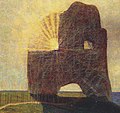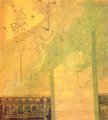Idioma-bot (talk | contribs) m robot Adding: bat-smg:Mikalojus Konstantinas Čiurlionis Modifying: uk:Чюрльоніс Мікалоюс Константінас |
No edit summary |
||
| Line 4: | Line 4: | ||
'''Mikalojus Konstantinas Čiurlionis''' ({{OldStyleDate|September 22|1875|September 10}} in [[Old Varėna]]—{{OldStyleDate|April 10|1911|March 28}} in [[Pustelnik]] near [[Warsaw]]) was a [[Lithuania]]n [[painter]] and [[composer]]. During his short life he composed about 250 pieces of music and created about 300 paintings.[http://neris.mii.lt/art/ciurlionis/chronol.html] The majority of his paintings are housed in the M. K. Čiurlionis National Museum of Art, in [[Kaunas]], [[Lithuania]]. His works have had a profound influence on modern Lithuanian culture. |
'''Mikalojus Konstantinas Čiurlionis''' ({{OldStyleDate|September 22|1875|September 10}} in [[Old Varėna]]—{{OldStyleDate|April 10|1911|March 28}} in [[Pustelnik]] near [[Warsaw]]) was a [[Lithuania]]n [[painter]] and [[composer]]. During his short life he composed about 250 pieces of music and created about 300 paintings.[http://neris.mii.lt/art/ciurlionis/chronol.html] The majority of his paintings are housed in the M. K. Čiurlionis National Museum of Art, in [[Kaunas]], [[Lithuania]]. His works have had a profound influence on modern Lithuanian culture. |
||
==Biography== |
|||
Čiurlionis was the oldest of nine children of his father, Constantine, and his mother, Adele. In 1878 his family moved to [[Druskininkai]], where his father became the town organist. Ciurlionis was a musical prodigy: he could play by ear at age three and could sightread music freely by age seven. Three years out of primary school, he went to study at the musical school of Prince Michał Origiski where he learned the instruments of the orchestra, in particular the flute, from 1889 to 1893 Čiurlionis studied piano and composition at the [[Warsaw]] [[Conservatory]] from 1894 to 1899. For his graduation, in 1899, he wrote a Cantata for mixed Chorus and symphoinic orchestra called "De Profundis," with the guidance of noted composer Symgund Noskowsky. Later he attended composition lectures at the [[Leipzig]] Conservatory (1901 to 1902), and studied drawing at the Warsaw School of Fine Arts from 1904 to 1906. |
Čiurlionis was the oldest of nine children of his father, Constantine, and his mother, Adele. In 1878 his family moved to [[Druskininkai]], where his father became the town organist. Ciurlionis was a musical prodigy: he could play by ear at age three and could sightread music freely by age seven. Three years out of primary school, he went to study at the musical school of Prince Michał Origiski where he learned the instruments of the orchestra, in particular the flute, from 1889 to 1893 Čiurlionis studied piano and composition at the [[Warsaw]] [[Conservatory]] from 1894 to 1899. For his graduation, in 1899, he wrote a Cantata for mixed Chorus and symphoinic orchestra called "De Profundis," with the guidance of noted composer Symgund Noskowsky. Later he attended composition lectures at the [[Leipzig]] Conservatory (1901 to 1902), and studied drawing at the Warsaw School of Fine Arts from 1904 to 1906. |
||
Revision as of 09:47, 22 June 2007

Mikalojus Konstantinas Čiurlionis (September 22 [O.S. September 10] 1875 in Old Varėna—April 10 [O.S. March 28] 1911 in Pustelnik near Warsaw) was a Lithuanian painter and composer. During his short life he composed about 250 pieces of music and created about 300 paintings.[1] The majority of his paintings are housed in the M. K. Čiurlionis National Museum of Art, in Kaunas, Lithuania. His works have had a profound influence on modern Lithuanian culture.
Biography
Čiurlionis was the oldest of nine children of his father, Constantine, and his mother, Adele. In 1878 his family moved to Druskininkai, where his father became the town organist. Ciurlionis was a musical prodigy: he could play by ear at age three and could sightread music freely by age seven. Three years out of primary school, he went to study at the musical school of Prince Michał Origiski where he learned the instruments of the orchestra, in particular the flute, from 1889 to 1893 Čiurlionis studied piano and composition at the Warsaw Conservatory from 1894 to 1899. For his graduation, in 1899, he wrote a Cantata for mixed Chorus and symphoinic orchestra called "De Profundis," with the guidance of noted composer Symgund Noskowsky. Later he attended composition lectures at the Leipzig Conservatory (1901 to 1902), and studied drawing at the Warsaw School of Fine Arts from 1904 to 1906.
He was one of the initiators of, and a participant in, the First Exhibition of Lithuanian Art that took place in Vilnius in 1907. Soon after this event the Lithuanian Union of Arts was founded, and Čiurlionis was of its nineteen founding members.
Čiurlionis felt that he was a synesthete; that is, he perceived colors and music simultaneously. Many of his paintings bear the names of musical pieces: sonatas, fugues, and preludes.
Some of his most-performed musical works include:
- Prelude in F Sharp major
- String Quartet in C minor
- Prelude in A major
- Karalaitės kelionė: Pasaka (The Princess' Journey, A Fairy Tale)
- Seven fugues for organ / String Quartet in C minor
- Folk songs for choir
- Miške (In the Forest), a symphonic poem for orchestra (posthumous)
- Jūra (The Sea), a symphonic poem for orchestra (posthumous)
Čiurlionis is buried in Vilnius' Rasos Cemetery.
- Čiurlionis' name has been given to cliffs in Franz Josef Land, a peak in the Pamir Mountains, and asteroid #2420.
- In 1957 the Lithuanian community in Chicago opened The Čiurlionis Art Gallery, hosting exhibitions of the Lithuanian painter's works. The National M. K. Čiurlionis School of Art was founded in Vilnius in 1945.
- The Čiurlionis String Quartet is performed in Lithuania and abroad. Every several years junior performers from Lithuania and neighbouring countries take part in The Čiurlionis Competition.
- The Lithuanian composer Osvaldas Balakauskas' work Sonata of the Mountains (1975) was inspired by the paintings of Čiurlionis.
- The M. K. Čiurlionis National Art museum in Kaunas holds collections of works by Čiurlionis, as well as Lithuanian and foreign fine and folk art. The M. K. Čiurlionis Memorial museum in Druskininkai is a branch of the museum in Kaunas; the exhibition includes biographical documents and photographs and reproductions of the artist's works.
Gallery
-
Cloud Boat
-
The Past
-
Crosses in Žemaitija
-
Spring Sonata: Andante
-
Spring Sonata: Scherzo




